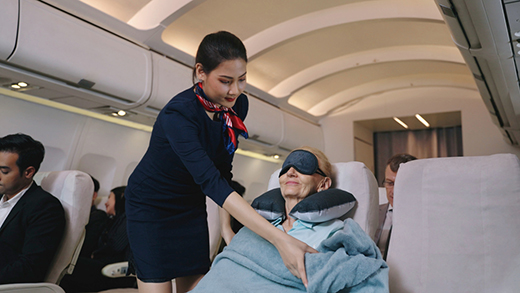By Neha Mehrotra
19-Jul-2024
Red-eye flights can be both a lifesaver and a stress-inducing ordeal. While the idea of boarding a plane, drifting off to sleep, and waking up in a new place sounds magical, the reality can sometimes be exhausting and overwhelming. Whether you’re jetting off on vacation or heading to a crucial business meeting, arriving bleary-eyed and out of sync with the local time zone is no one’s idea of fun. Therefore, it becomes extremely important to take care of yourself while you’re crammed in a metal tube hurtling through the sky at ungodly hours.
We asked Captain Zoya Agarwal, a seasoned aviation leader and the world's youngest woman commander to fly the Boeing-777 and the first female commander to fly over the North Pole, to share expert tips on how to take care of ourselves before, after and during a red- eye flight. Take notes!
What are Red-eye Flights?
A red-eye flight refers to a flight that departs at night and arrives the next morning, especially when the total flight time is insufficient for you to get a full night's sleep—hence the term. “Red-eye flights are quite the adventure! People choose them for various reasons—some to save time and others to save money. Both choices are equally valid and welcomed by us," explains Captain Zoya Agarwal. “Our passengers are valued guests, and we strive to make their journey as comfortable as possible. Personally, I think red-eye flights offer great flexibility," she further adds.
How to Take Care of Yourself During a Red- Eye Flight
1. Stay Hydrated and Moisturised: The cabin environment, including factors like temperature and humidity, significantly impacts your sleep and comfort during a red-eye flight. The dry air and low pressure can cause dehydration and fatigue. "To adjust, I recommend staying hydrated and using a good moisturiser with UV protection. Even though UV radiation is minimal at night, it's a good habit to maintain because you'll likely be getting off the flight during the day. As you approach daytime, especially depending on your geographical location, UV radiation can increase," explains Captain Zoya. A common mistake that passengers make is not drinking enough water. It's easy to forget, but staying hydrated is crucial, especially on long-haul flights. Consuming alcohol and coffee can also dehydrate you, so it's best to avoid them.
2. Movement is the Key: For frequent flyers, the discomfort of sitting in one place for extended periods of time is all too familiar. Prolonged immobility can lead to stiffness in your back, neck, and legs. "It's very important to move around a bit and try to stretch if possible. Simple exercises like neck rolls and ankle circles can do wonders for alleviating tension and promoting relaxation," Captain Zoya advises. Neck rolls help to release tightness in your shoulders and upper back, while ankle circles can improve blood flow and reduce the risk of swelling in your lower extremities. She also recommends taking short walks up and down the aisle whenever it's safe to do so. "Even a brief stroll can help prevent stiffness and improve circulation," she says. You can consider performing seated stretches, such as lifting your knees to your chest, gently twisting your torso to each side, or extending your legs and flexing your feet.

3. Manage your Sleep: Whether you're on a red eye flight or travelling between time zones, getting some sleep on a flight is a great way to pass the time. To sleep comfortably, you can pack some items like a neck pillow, an eye mask and a pair of earplugs. “Many passengers spend too much time on their phones or devices, which can strain their eyes, especially in a darker environment, and prevent them from getting proper rest," explains Captain Zoya. Staying away from blue light is important because it can disrupt your sleep and prevent you from feeling refreshed. Use the red-eye flight as an opportunity to catch some rest so that you are ready to take on the day when you arrive.
4. Wear Comfortable Clothing: A change in geographical location often brings a shift in weather conditions, making it important to dress strategically without sacrificing comfort. Captain Zoya recommends dressing in layers to easily manage temperature changes and stay comfortable upon arrival. When travelling overnight, avoid wearing stiff jeans or tight-fitting clothes. The ideal outfit for a plane should be both comfortable and presentable. A soft pair of leggings paired with a jacket is a reliable choice. Alternatively, you can opt for a matching loungewear set in soft fabric and slip-on shoes. If you're prone to swelling, consider wearing cosy bed socks or compression socks. This approach ensures you remain comfortable throughout the flight and are ready for whatever climate awaits you at your destination.

5. Be Mindful of When and What You Eat: “I’d suggest avoiding heavy meals and alcohol right before you fly. Eating a large meal can make it harder to fall asleep and cause discomfort," Captain Zoya explains. While a glass of wine might help you relax, alcohol can dehydrate your body, and the dry air in the cabin will dehydrate you further. “This can disrupt your sleep and leave you feeling less refreshed. Instead, opt for a light snack and plenty of water,“ she recommends.